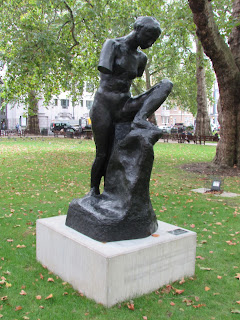Thomas Houseago - Lava Mask
"There is in Rodin a very pagan concern for the life-death continuum: clay as a manifestation of life and death. . . . It is a way of reminding us about the complexity of being in a body, of being alive." —Thomas Houseago.
Thomas Houseago - Gold Walking Man and Auguste Rodin - Pierre de Wissant
Another exhibition of three-dimensional art in the capital at the moment. This is one of those exhibitions comparing and contrasting two practitioners past and contemporary of an artistic discipline, in this case sculpture, hoping to form a "dialogue" between their varying styles. The participants here at Gagosian Davies Street are Auguste Rodin (1840-1917), and Thomas Houseago, and the work featured here consists of two very different sculptural styles to that of the hyperrealistic figures of Ron Mueck in my last post. In the main exhibition space Rodin is represented by three elegant, naturalistic, life-sized figures caught in a series of movements ranging from the reposed to the dynamic. There is also a further Rodin statue situated in the garden space of Berkeley Square a short stroll away. All the Rodin sculptures here posess a certain immediacy, tension and yet relaxed, lyrical naturalism, as if captured unawares for a split second in their exertions. Houseago's muscular, hulking, Gold Walking Man, situated in this space seeks to assert himself among the power of the Rodins through sheer scale, force of will and physicality, like Ted Hughes's Iron Man. In contrast to the lyrical bronzes of Rodin, Houseago's stiff, lumpen, muscular, golden man strides assuredly and purposefully, asserting his right to be in the presence of the master Rodin. It is interesting to be able to see the exposed armature infrastructure supporting the Gold Walking Man's bulk. This is a part of Houseago's deliberate, rough hewn, signature visual language. Having negotiated the stand off between these figures in the main room I ventured into the smaller, darkened back room to encounter a series of smaller works by both artists again contrasting the different approaches to their sculptural discipline. Houseago's works here intrigued me greatly especially the pieces in which he used casts of dentures, blending these with found materials such as forks, spoons, glass jars and jewellery. I liked the small talismanic masks of his which look as though they could have been created by earlier cultures. The presence of the larger skull on a plinth in this room I personally think really doesn't do him any favours. Rodin's smaller works in this space are just amazing, justifying his reputation. They are complex and full of movement, especially the sensuous female nude twisting to her right, which is so reminiscent and comparable to the nudes of Michelangelo. Back in the main room there are a series of Houseago masks aligned on the wall which display the influence of Picasso's simple cardboard constructions and larger Cubistic sculptures. They could also have taken their cue from Henry Moore's series of helmeted heads. They are interesting exercises in the arrangement and layering of simple, flattened shapes to create structural three dimensional forms. This was an interesting little show. It suffered however. The small, main exhibition space did both sculptors no favours in that there wasn't enough room to move around the larger sculptures, or stand back and fully appreciate their juxtapositions, volume and space they occupied in relation to each other.

Auguste Rodin - Aphrodite, grande modèle, 1914
Auguste Rodin - Fils d'Ugolin, sans tête, grande modèle, 1904
Auguste Rodin - Pierre de Wissant, nu monumental sans tête ni mains, 1886




























No comments:
Post a Comment